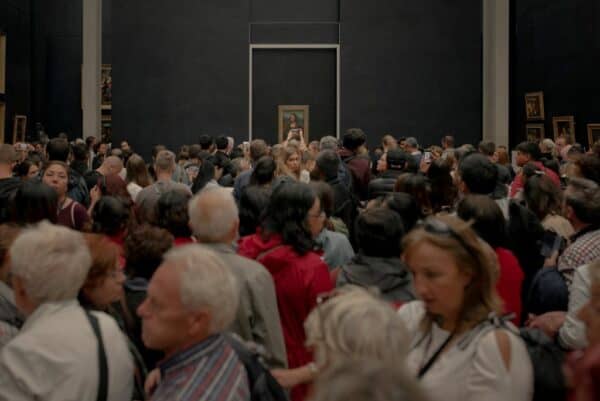Conclusion: New Challenges
The Covid 19 pandemic posed new problems but also new challenges for Museums, Galleries, and all art curators. The impossibility of physical visits to exhibitions and museums or, when possible, restrictions on the number of people and security rules have posed serious organizational problems.
Mega exhibitions with thousands of visitors or endless queues are now a thing of the past.
The image below, published in the New Your Times in November 2020 is no longer part of our reality.
Visitors to the Louvre to see the Mona Lisa on Oct. 24. Each day, 30,000 people pass through the gallery where Leonardo’s painting hangs, according to the museum’s director. Credit Elliott Verdier for The New York Times.
What was already a trend – digital exhibitions – as an alternative to physical visits, became the way to communicate about art par excellence.
In many cases, the only way to reach our audiences.
Digital exhibitions
- As a consequence, digital exhibitions have multiplied, at a rate never seen and never expected.
- Museums were among the institutions most affected by the pandemic, in some cases with catastrophic consequences and closure.
- And they were the first to use digital tools to communicate and exhibit art.
- From digital exhibitions via Google Arts Culture to the full digitization of collections, including visits to physical exhibitions on video and explained by curators, we have access to numerous new forms of digital communication.
Just a few examples of digital exhibitions formats:
Step Inside the Forbidden City
On its 600th anniversary, discover China’s famous forbidden city and explore its architectural wonders and precious artifacts.
Google Arts and Culture
The Acropolis Museum – Athens, Greece – is now entirely digital. It is not just about creating virtual visits to the Museum. But a complete project that, through various applications, integrates detailed information about the works of the permanent exhibition, galleries and virtual exhibitions, videos, and interactive experiences.
Children have their own space at the Acropolis Digital Museum with the Acropolis Museum Kids, which includes videos and games.
This is a visit to the Victoria and Albert Museum exhibition, in 5 episodes through videos published on Youtube.
What will be the future of art exhibitions? Are we going to have physical exhibitions with the same dimensions as before?
We don’t know how to answer these questions.
The challenges facing art curatorship are immense and never before the imagination, daring, and capacity for innovation have been so important for art curators.
But there is one thing that hasn’t changed: an art exhibition, whatever its format, whatever its size, whatever its budget, whatever the context in which the exhibition will be held, whether digital or live, is always a communication project.
As interesting and appealing the digital tools used are, an exhibition always requires accurate prior work:
- Investigation
- Definition of themes and objectives
- Definition of target audiences
- Programming
- Choice of team and “works”
- Assembly (although virtual, the choice of digital tools and suitable methods is very important)
- Disclosure
- Visitor reception
- Monitoring and evaluation of results
We don’t know the future but we know that now the role of the art curator is to produce exhibitions using the digital format. But always take into account the exhibition project.
The use of digital tools, apparently simple, requires even more work, attention, and rigor on the part of art curators.
